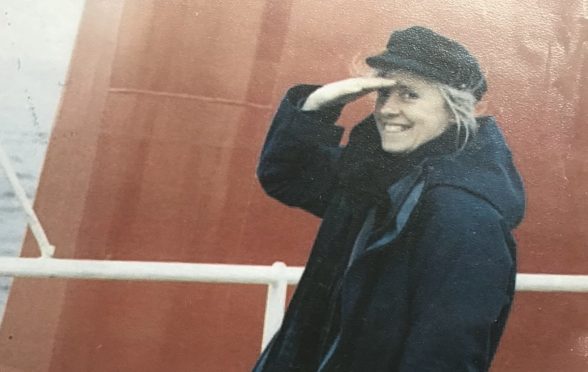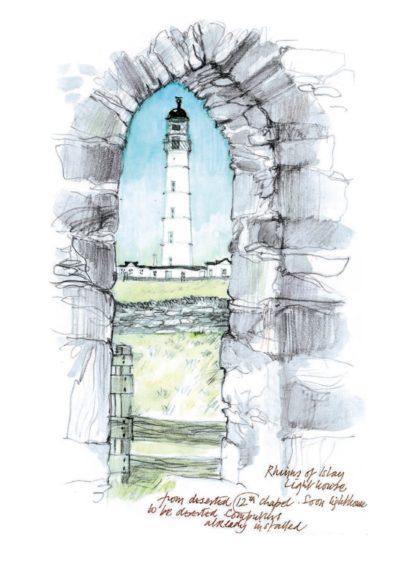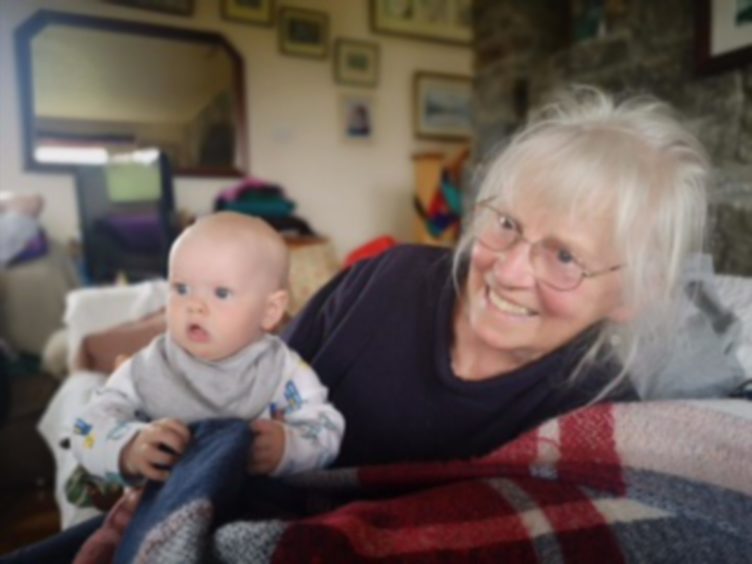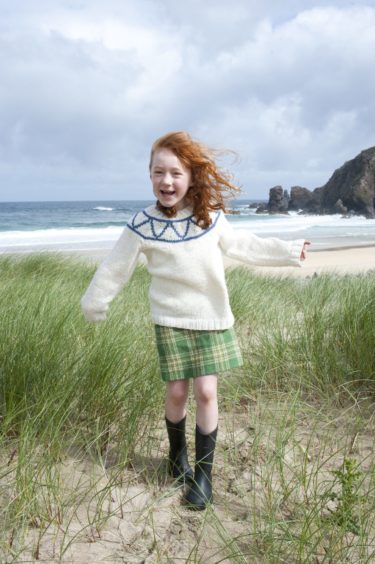
Her stories of a flame-haired island girl have captured the imagination and inspired a love of reading in generations of children.
But, looking back over her acclaimed career as an author and illustrator, Mairi Hedderwick says she always hoped her Katie Morag books would not only encourage young readers to “explore the rhythms and richness of language” but to share her passion for adventure and exploration.
Although best known for her children’s books set on the fictional Isle of Struay, this month marks the reissue of Hedderwick’s best-selling non-fiction travel book, An Eye On The Hebrides, which details her six-month solo journey through Scotland’s rugged west-coast terrain.
Perfectly exemplifying her desire to wander off the beaten track, the guide starts with Hedderwick setting out in 1988 in the Blue Lady, her beloved campervan, armed with her sketchbook and watercolours for a journey that she still recalls vividly.
“I was living on the mainland but the islands still exerted a huge pull on me,” explained Hedderwick, 82, who was born and brought up in Gourock but developed a love for the Hebrides after visiting Coll as a teenager.
“The islands were – and still are – forever calling. I recall nearly every detail of that trip as though it was yesterday. This was my journey of self-discovery – 40 islands, 750 sea miles, 45,000 land miles, 30 boats, and innumerable breakdowns. I remember the big island storms, the seasickness – and the travel pills, the wrist bands, the apple and brown bread, all meant to prevent the worst effects – the sunstroke, and the millions of midges. And I remember the generosity of the people.”
The book, beautifully illustrated, features stories from Colonsay and Oronsay to Muck, Eigg, Rum and Canna but the writer admits the leg of her journey she remembers most fondly was two weeks in St Kilda. Travelling to the secluded spot took nine hours on an Army landing craft.
She said: “At first they suggested my journey to St Kilda should be followed by only six hours on land. I could not cope with the thought of that turnaround – it would not even have given time for recovery from the sea voyage! The alternative was two and a half weeks on the island, and that was the option I took.
“The voyage there, in the Atlantic swell, was rough to say the least including the approach to the group of islands that make up St Kilda; Hirta, the main island, Dun, Soay, Boreray and Stacks. But I survived. I was staying with the young National Trust wardens on Hirta but took an Army inflatable to Dun. Then I left St Kilda as I arrived, under cover of darkness, but this time I threw a message in a bottle into the wild seas. I still wonder if it was ever found.”
She added: “There is no particular island that I could say I liked the best. The perfect island would be an amalgam of them all but St Kilda is the location I had initially thought of as the ultimate in Hebridean dream islands.”
Hedderwick joined Coll’s community – the island is only 13 miles long by three miles wide – in the ’60s and stayed for the next decade, raising her two children, Mark and Tammie. The family moved back to the mainland so the children could attend high school but the pull of the islands, as Hedderwick puts it, was still strong. Having illustrated books for other writers, she was encouraged to create her own fictional account of their life on the islands, and Katie Morag was born.
The first paperback, Katie Morag Delivers The Mail, was published in 1984 with a further 14 tales following over the next two decades. In that time, Hedderwick lived all across Scotland, and her fascination with exploring Scotland’s natural beauty inspired much of her writing.
In addition to An Eye On The Hebrides, she penned further travel books for adults, including Highland Journey and Shetland Rambles, both of which saw her follow quite literally in the footsteps of Victorian artist John T Reid.
The urge to keep moving was at the heart of her journeys – but Scotland always called her home. She said: “I continued to travel – through Argentina, south-east Asia, Portugal, Croatia and retracing my missionary grandfather’s steps in Africa – until I was 79.
“I’ve lived in Gourock, Edinburgh, Glasgow, mid-Argyll, Applecross, Lochaber, Inverness-shire, the Borders, the Black Isle and Coll. What makes our country so beautiful is probably the variety in our surroundings – in nature, in scenery, in the constantly changing and unpredictable weather that brings with it variation in light that can only be captured in sketchbooks. You don’t know what to expect hour on hour.
“Life has taken me in many different directions and I still long for the island life from time to time. I am a great-grandmother now and live happily on the mainland but I do visit my family on the island of Coll whenever I can.”
In recent years, Hedderwick’s desire to travel and explore has been put on hold after she suffered a serious stroke. Still in recovery, she admits lockdown has been difficult, especially as her speech has been impaired.
“I was left with aphasia, a complex communication disorder, and felt a depression unlike any I had experienced before,” she said. “I found it hard to accept at first but received a great deal of support from those around me and from a volunteer from the Chest, Heart and Stroke charity.
“I was beginning to feel more confident speaking to people when lockdown took away my opportunity to practise with family and friends. But I am now walking and talking with friends whenever possible.”
Her unexpected career as one of Scotland’s most popular authors and illustrators may have sealed her place in the history books but, Hedderwick admits, she’s just glad to have experienced life to the full.
“Living life on my own terms is probably my proudest achievement. And hopefully Katie Morag and my work also instilled in others a hunger for adventure and exploration.”
Seals sunbathed on the rocks, flippers arched, under a Greek-blue sky
Here, in an extract from An Eye On The Hebrides, Mairi Hedderwick visits Islay.
With the vagaries of a planet at climatic war with itself, the latter part of the Islay visit was burnished with brilliant sun. But still that bitter wind.
A late-night phone call from the call box above the Cornish-style port of Portnahaven was lit by a full frost-ringed moon and the intermittent sweep of the Rhinns of Islay Lighthouse.
Next day I found a boatman willing to take me over to one of the seven remaining manned lighthouses on the west coast: Ailsa Craig, Pladda, Rhinns of Islay, Skerryvore, Hyskeir (Oban), Butt of Lewis and Cape Wrath. The writing was on the dazzling white walls of the Rhinns, however. The three keepers – alternate month on and off – were waiting for the final axe. Computers had already been installed.
We mused over the previous week’s news headlines that told of the electric train that had travelled 36 miles, unmanned, on the Brighton line and wondered for the automated safety of the seas around our coasts.
A colony of seals sunbathed on the rocks, tail flippers ecstatically arched to the Greek-blue sky. Alistair pointed out his pet. Born last.
September on the lighthouse jetty and subsequently familiar with humans during its land-based puphood, it was very obviously apart from the rest of the clan. “He’s always like that. It is almost as though his mother had rejected him right from the beginning by giving birth on the jetty.”
I had the fanciful notion of a tired, even flippity, young mother seal depositing her burden, calculatedly, hoping for a foundling’s future for her unwanted offspring.
I thought Islay was the friendliest place I had yet been to; almost to the point of suspicious effusiveness. Everywhere, but everywhere, people waved as the van and I passed. It was not until leaving I learnt that the lady at the Port Charlotte Museum had the exact same model, colour and year registration of VW caravanette.
How could there possibly be a twin to my old Blue Lady?
We were still in love with each other, the van and me.
An Eye On The Hebrides: An Illustrated Journey by Mairi Hedderwick, Birlinn

Enjoy the convenience of having The Sunday Post delivered as a digital ePaper straight to your smartphone, tablet or computer.
Subscribe for only £5.49 a month and enjoy all the benefits of the printed paper as a digital replica.
Subscribe © Supplied
© Supplied © SYSTEM
© SYSTEM © BBC/Move On Up
© BBC/Move On Up